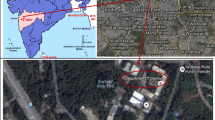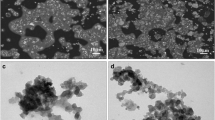Abstract
Based on the study of Beijing PM10 bioreactivity with the newly developed plasmid DNA assay method, and analysis for trace elements of PM10, the cause of plasmid DNA damage by PM10 was investigated. The study showed that plasmid DNA oxidative damages by PM10 are of difference in different seasons at various areas. The concentrations of TM50 of PM10 in whole samples respectively collected at urban and comparison sites during winter were 900 μg mL−1 and 74 μg mL−1, while those in their corresponding soluble fractions were 540 μg mL−1 and 86 μg mL−1. In contrast, TM50 contents of PM10 from summer whole samples at urban areas and comparison sites were 116 μg mL−1 and 210 μg mL−1, whereas those in their soluble fractions were 180 μg mL−1 and 306 μg mL−1. The difference of bioreactivity of Beijing PM10 resulted from the variation of trace elements. The oxidative damage of plasmid DNA caused by Pb, Zn, As in PM10 (whole sample) was relatively strong. TM50 and Mn, V, Zn display stronger correlation in the soluble fraction. It implies that Zn could be the major trace element in Beijing PM10 which contributes to oxidative damage to plasmid DNA.
Similar content being viewed by others
References
Wei F S, Chapman R S. Study on Effect of Air Pollution on Respiratory Health Effect (in Chinese). Beijing: China Environmental Science Press, 2001. 1–16
Chapman R S, Watkinson W P, Dreher K L, et al. Ambient particulate matter and respiratory and cardiovascular illness in adults: particle-borne transition metals and the heart-lung axis. Environ Toxicol and Pharmacol, 1997, 4: 331–338
Donaldson K, Beswick P H, Gilmour P S. Free radical activity associated with the surface of particles: a unifying factor in determining biological activity? Toxicol Lett, 1996, 293–298
Donaldson K, Brown D M, Mitchell C, et al. Free radical activity of PM10: iron-mediated generation of hydroxyl radicals. Environ Health Perspect, 1997, 105(S5): 1285–1289
Donaldson K, Li X, MacNee W. Ultrafine (Nanometer) particle mediated lung injury. J Aero Sci, 1998, 29: 553–560
Li X, Gilmour P S, Donaldson K, et al. In vivo and in vitro proin-flammatory effects of particulate air pollution (PM10). Environ Health Perspect, 1997, 105(S5): 1279–1283
Greenwell L L, Moreno T, Jones T P, et al. Particle-induced oxidative damage is ameliorated by pulmonary antioxidants. Free Radical Biol Medi, 2002, 32, 898–905
Greenwell L L, Moreno T, Richard R J. Pulmonary antioxidants exert differential protective effects against urban and industrial particulate matter. J Biosci, 2003, 28(1): 101–107
Poli G, Parola M. Oxidative damage and fibrogenesis. Free Radical Biol Medi, 1996, 22: 287–305
Costa D L, Dreher K L. Bioavailable transition metals in particulate matter mediate cardiopulmonary injury in healthy and compromised animal models. Environ Health Perspect, 1997, 105(Suppl. 5): 1053–1060
Richards R J, Atkins J, Marrs T C, et al. The biochemical and pathological changes produced by the intraacheal instillation of certain components of zinc hexachloroethane smoke. Toxicol Lett, 1989, 54: 79–88
Adamson I Y R, Prieditis H, Hedgecock C, et al. Zinc is the toxic factor in the lung response to an atmospheric particulate sample. Toxicol Appl Pharmacol, 2000, 166: 111–119
Wang Y Q, Zhang L G, Dai S, et al. Generation of reactive oxygen species mediated by iron on inhalable particles and effects on lung injury. Adv Environ Sci (in Chinese), 1999, (S): 118–123
Valavanidis A, Salika A, Theodoropoulou A. Generation of hydroxyl radicals by urban suspended particulate air matter: the role of iron ions. Atmos Environ, 2000, 34: 2379–2386
Ambroz H B, Bradshaw T K, Kemp T J, et al. Role of iron ions in damage to DNA: influence of ionizing radiation, UV light and H2O2. J Photochem Photobiol A: Chemistry, 2000, 142: 9–18
Kim B Y, Han M J, Chung A S. Effects of reactive oxygen species on proliferation of Chinese hamster lung fibroblast (V79) cells. Free Radical Biol & Medi, 2001, 30(6): 686–698
Gilmour P S, Brown D M, Beswick P H, et al. Free radical activity of industrial fibers: role of iron in oxidative stress and activation of transcription factors. Environ Health Perspect, 1997, 105(S5): 1313–1317
Beijing Environmental Protection Bureau. Ann Environ Bull (1996–2000) (in Chinese). 2001
Chang H, Yang S J, Dong J Q, et al. Study on the element species of atmosphere aerosol. Environ Chem (in Chinese), 2000, 19(6): 485–499
Huang X, Olmez I, Aras N K, et al. Emissions of trace elements from motor vehicles: Potential marker elements and source composition profile. Atmos Environ, 1994, 28: 1385–1391
Zhang R J, Xu Y F, Han Z U. Inorganic chemical composition and source signature of PM2.5 in Beijing during ACE-Asia period. Chin Sci Bull, 2003, 48(10): 1002–1005
Xie H, Wang G C, Ren L X, et al. Study on chemical composition of the atmospheric fine aerosol in Beijing city. Chin Environ Sci (in Chinese), 2001, 21: 432–435
Derrick E. Smog alarm (in Chinese). Beijing: Science Press, 1999. 32–75
Zhuang G S, Guo J H, Yuan H, et al. Coupling and feedback between iron and sulphur in air-sea exchange. Chin Sci Bull, 2003, 48(11): 1080–1086
Imrich A, Ning Y Y, Kobzik L. Insoluble components of concentrated air particles mediated alveolar macrophage responses in Vitro. Toxicol and Appl Pharmacol, 2000, 167: 140–150
Author information
Authors and Affiliations
Corresponding author
Rights and permissions
About this article
Cite this article
Lü, S., Shao, L., Wu, M. et al. Correlation between plasmid DNA damage induced by PM10 and trace metals in inhalable particulate matters in Beijing air. SCI CHINA SER D 49, 1323–1331 (2006). https://doi.org/10.1007/s11430-006-2020-y
Received:
Accepted:
Issue Date:
DOI: https://doi.org/10.1007/s11430-006-2020-y




